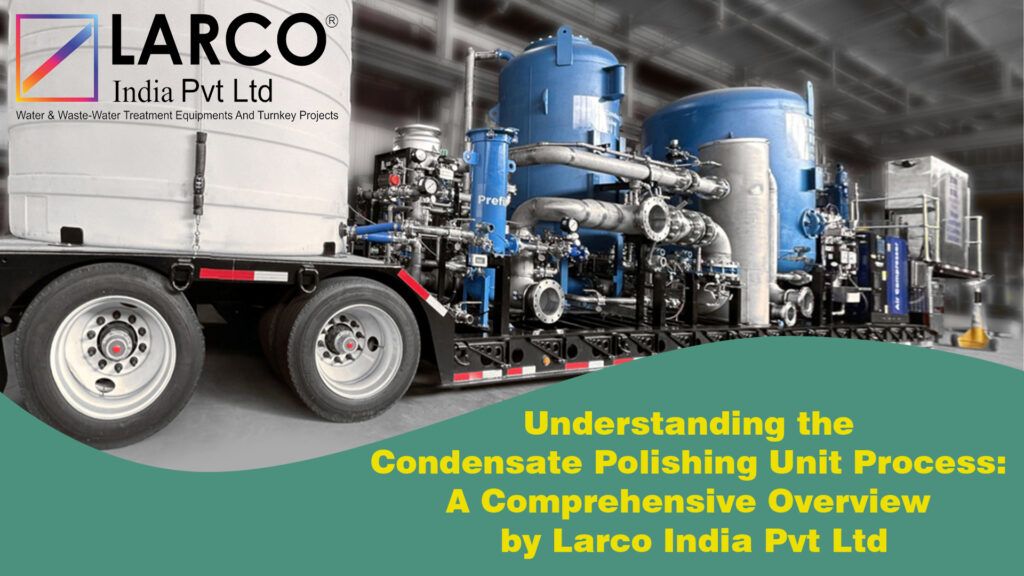Power plants, industrial facilities, and other settings where water purity is important depend on condensate polishing unit (CPU). Larco India Pvt Ltd, a leading supplier of water treatment solutions, will discuss the condensate polishing unit process, its importance, and how it helps maintain the effectiveness and dependability of various systems in this blog post.
The Significance of Condensate Polishing Unit process: Condensate is the term for the water that results from the condensation of steam, and it suffers from debris, dissolved gases, and corrosion products. Ineffective removal of these contaminants can lead to fouling, corrosion, and equipment damage. Condensate Polishing Units ensure high-quality water for steam generation and other activities by eliminating these pollutants as the final line of defense in water purification systems.
Basic Components of a Condensate Polishing Unit Process: A typical CPU comprises several essential components.
- Condensate Polishers: These containers hold ion exchange resin beds, which filter and remove contaminants from condensate water.
- Pre-filtration System: To remove suspended solids and bigger particles, it uses a variety of filters, including cartridge filters and multimedia filters.
- Chemical Addition System: In order to improve water quality and avoid corrosion, this system introduces specialized chemicals, such as pH adjusters and oxygen hunters.
- Instrumentation and Control: To keep the CPU working at peak efficiency and provide optimal operating conditions, monitoring and control techniques will require.
Following all the steps that make up the Condensate Polishing Unit process
Step 1: Condensate Inlet: The condensation from the steam condenser enters the CPU following the condensation of the steam. Typically, it includes corrosion byproducts, dissolved gases, and suspended solids.
Step 2: Pre-filtration: Condensate flows through a number of pre-filters that get rid of impurities like rust flakes and suspended solids. The ion exchange resins used in the following stage remain safe through this process.
Step 3: Ion Exchange Resin Beds: Ion exchange resin-containing condensate polishers receive the pre-filtered condensate. These resins selectively draw in and exchange ions with the water’s impurities. Strong base anion and weak acid cation resins are the two most widely utilized types of resins.
Step 4: Regeneration: The ion exchange resins need refreshing since they eventually become saturated with impurities. In order to accomplish this, a regenerant solution passes through the resin beds, exchanging the trapped ions for new ones. The regenerant solution can vary depending on the specific resin used.
Step 5: Polished Condensate Outlet: After passing through the ion exchange resin beds and undergoing regeneration, the condensate emerges purified and ready for reuse. It is now free from impurities, such as dissolved gases, corrosive ions, and particulate matter.
Advantages of CPU Process:
- Improved System Performance: CPU ensures that the steam generation process remains efficient, minimizing the risk of corrosion, fouling, and equipment failures.
- Cost Savings: By maintaining the purity of the condensate, the CPU helps reduce maintenance costs and downtime associated with equipment failures.
- Environmental Benefits: By removing impurities from the condensate, CPU helps prevent pollution and minimizes the environmental impact associated with water discharge.
Conclusion: Condensate Polishing Unit process are critical components of water treatment systems in various industries. Larco India Pvt Ltd recognizes the importance of ensuring high-quality water for optimal system performance. By understanding the condensate polishing unit process, organizations can make informed decisions about incorporating this technology to enhance efficiency, extend equipment life, and reduce operational costs. Contact Larco India Pvt Ltd today to explore how their expertise in water treatment can benefit your facility.

